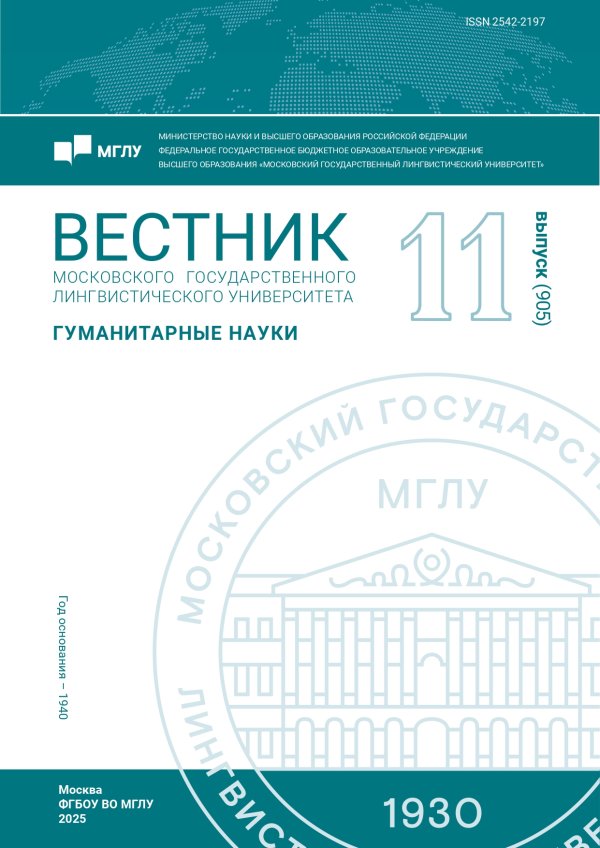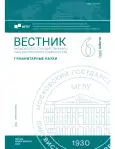Вербально-жестовое поведение в устном нарративе: юмор в гендерном аспекте
- Авторы: Томская М.В.1
-
Учреждения:
- Московский государственный лингвистический университет
- Выпуск: № 6(887) (2024)
- Страницы: 106-112
- Раздел: Языкознание
- URL: https://ogarev-online.ru/2542-2197/article/view/303245
- ID: 303245
Цитировать
Полный текст
Аннотация
В настоящей статье рассматривается вербально-жестовое поведение говорящих в устном спонтанном нарративе, а также гендерный аспект юмора. В результате эмпирического анализа устных нарративов были выявлены некоторые тенденции в вербально-жестовом поведении мужчин и женщин при порождении шутливых высказываний, в частности, отмечено количественное преобладание репрезентирующих жестов, а также частотное использование юмора мужчинами в устном спонтанном нарративе.
Ключевые слова
Об авторах
Мария Викторовна Томская
Московский государственный лингвистический университет
Автор, ответственный за переписку.
Email: maria.tomskaya@mail.ru
кандидат филологических наук, доцент, зав. лабораторией гендерных исследований Центра СКоДис, доцент кафедры лингвистики и профессиональной коммуникации в области права
РоссияСписок литературы
- Martineau W. H. A model of the social functions of humor // The psychology of humor / ed. by J. Goldstein, P. McGhee. New York: Academic Press, 1972. Р. 101–125.
- Crawford C. B. Theory and implications regarding the utilization of strategic humor by leaders // The Journal of Leadership Studies. 1994. Vol. 1 (4). Р. 53–68.
- Müller C. Redebegleitende Gesten. Kulturgeschichte – Theorie – Sprachvergleich. Berlin: Berlin Verlag, 1998.
- Cienki A. Cognitive linguistics: Spoken language and gesture as expressions of conceptualization // Body – Language – Communication: An international handbook on multimodality in human interaction / Ed. by C. Müller, A. Cienki, S. Ladewig, D. McNeill, S. Teßendorf. Berlin: Mouton de Gruyter, 2013. Vol. 1. P. 182–201.
- Freud S. Der Witz und seine Beziehung zum Unbewussten. Frankfurt a. M.: Fischer, 1985.
- Hampes W. P. The relationship between humor and trust // Humor. 1999. Vol. 12 (3). P. 253–260.
- Martin R. A. et al. Individual differences in uses of humor and their relation to psychological well-being: Development of the humor styles questionnaire / R. A. Martin, P. Puhlik-Doris, G. Larsen, J. Gray, K. Weir // Journal of Research in Personality. 2003. Vol. 37 (1). Р. 48–75.
- Kotthoff H. Spaß Verstehen. Zur Pragmatik von konversationellem Humor. Tübingen: Niemeyer, 1998.
- Kotthoff H. Gender and joking. On the complexities of women’s image politics in humorous narratives // Journal of pragmatics. 2000. 32. Р. 55–80.
- Crawford M. Gender and humor in social context // Journal of pragmatics 2003. 35(9). Р. 1413–1430. DOI:10.1016/ S0378-2166(02)00183-2
- Coates J. Gender and humor in everyday conversation // Gender and humour. Interdisciplinary and international perspectives / ed. by D. Chiaro, R. Baccolini. London/New York: Routledge, 2014. Р. 147–165.
- Martin R. A. Humor and gender. An overview of psychological research // Gender and humour. Interdisciplinary and inter-national perspectives / ed. by D. Chiaro, R. Baccolini. London/New York: Routledge, 2016. Р. 123–147.
- Holmes J., Stubbe M. “Feminine” Workplaces: Stereotype and Reality // The Handbook of language and gender / ed. by J. Holmes, M. Meyerhoff. London: Blackwell, 2003. Р. 573–600.
- Kotthoff H. Gender and humour: The new state of the art // Linguistic online. 2022. Vol. 118(6). Р. 57–80. doi: 10.13092/lo.118.9084.
- Рябухина (Рашина) А. А. Жестовое поведение при порождении иронического высказывания: гендерный аспект // Вестник Московского государственного лингвистического университета. Гуманитарные науки. 2023. Вып. 5 (873). С. 100–106. doi: 10.52070/2542-2197_2023_5_873_100
Дополнительные файлы











